#common hippopotamus
Text

Common hippopotamus Hippopotamus amphibius
With African painted dog Lycaon pictus
Observed by bethpratt1, CC BY-NC-ND
#Hippopotamus amphibius#common hippopotamus#Hippopotamidae#hippo#non-ungulate#carnivoran#dog#Lycaon pictus#African painted dog#Africa#Zimbabwe
32 notes
·
View notes
Text
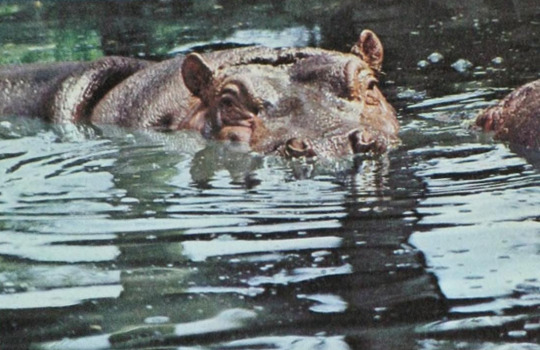
Common hippopotamus
By: Unknown photographer
From: Disney’s Wonderful World of Knowledge
1973
61 notes
·
View notes
Text
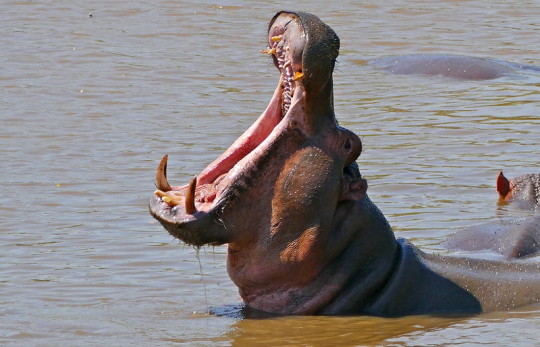
A hippopotamus (Hippopotamus amphibius) yawns in Kruger National Park, South Africa
by Bernard Dupont
#common hippopotamus#hippo#hippopotamus amphibius#hippopotamus#Hippopotamidaeae#artiodactyla#mammalia#chordata#wildlife: south africa#wildlife: africa
104 notes
·
View notes
Text
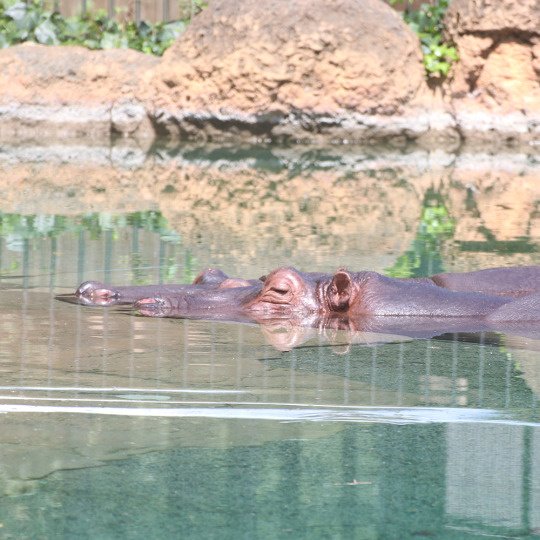

広いのに、ずっと寄り添って寝てて可愛かった
二枚目は展望台から撮りました
@豊橋動植物公園
Despite their large pond, they were snuggled up together, and I captured it from the observation tower. Cute!
@Toyohashi Zoo & Botanical Park
28 notes
·
View notes
Photo
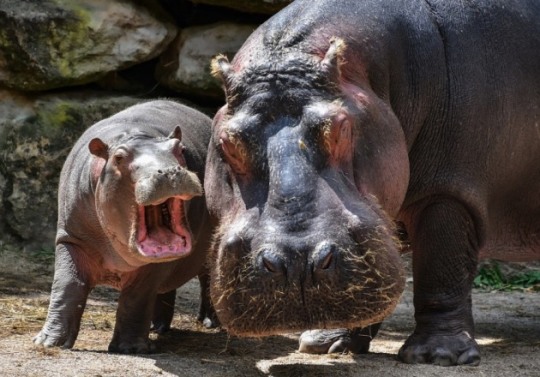
Animal of the Day:
Common Hippopotamus
2 notes
·
View notes
Text
The hippopotamus does not produce pink milk. Hipposudoric acid, a red pigment found in hippo skin secretions, does not affect the color of their milk, which is white or beige.[431]

0 notes
Text
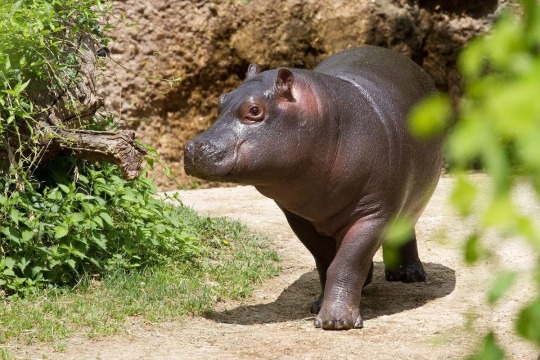
Pygmy hippopotamus (Choeropsis liberiensis)
Hippos are often thought of as savanna animals, but the pygmy hippopotamus is adapted to live in the jungles of Western Africa. It can be thought of as a sort of combination of the common hippo and a forest hog or tapir. By day they rest in water in secluded parts of the forest. At night, they go out foraging for food, including ferns, fruits, and basically any other plants close to the ground. They might be called pygmy hippos, but their size is still nothing to scoff at!
#markhors-menagerie#animal facts#animals#biology#fun facts#ungulates#even toed ungulates#pigs hippos & kin#hippopotamus#Pygmy hippopotamus
86 notes
·
View notes
Text
TAWERET
I WANT TO TALK ABOUT TAWERET!
I’ve been putting this off for a while and I need to discuss Taweret! Let’s go!
So who is Taweret. (Disclaimer: I am not an expert on Egyptology or mythology in relation, I’ve only done a little research).
Taweret is a goddess that gained increasing power and placement throughout Ancient history.
She is described as having the head of a Hippopotamus, arms/paws of a lion, and tail and legs of a crocodile.
That is one strong and fierce combination. They looked around Egypt and went, “What is the scariest things we have out here?”
So what is her place? Fertility and Rejuvenation (Goddess of pure water from the nile). Okay, They loved that shit back then. Makes sense.
Oh, and Protector of Women and Children.
It was common to find pictures of her around the homes of new born babies and young children. She was painted on their cups and plates, had little statues placed near their cribs.
She was fierce and terrifying. She was meant to protect the children from illness and ill intent. She was motherly and protective. She kept harm from them and the family. It was believed that if you raised a hand to your child or wife, you would face Taweret.
So what DOES happen in the afterlife? Where does Taweret fall into play?
When you died, you came before a series of judges who would ask you questions. (Book of the Dead was an instruction manual filled with how you were supposed to answer these questions, as well as spells to help keep you true).
Once you answered the questions your heart was weighed against the feather of Ma’at. If your scales did not balance, you were fed to Ammit. If your scales are balanced, you would be welcomed to the afterlife by Osiris.
In the afterlife, you were given a plot of land to do with as you wished and expected to maintain it. It was filled with abundance and everything you could need to be happy and good of heart (including worship of the gods). It was supposed to reflect the world that they had left behind (hence taking all your things with you in death that brought you joy in life).
So what place did Taweret have in the afterlife?
Taweret held the role of funerary deity. She was in charge of rebirth and passing into the afterlife. She became the center of homes in the New Kingdom, becoming related to life-giving regeneration, rebirth, and purifying.
At times, she was seen as the opposite of Ammit, who was the devourer of the impure soul and path to darkness. Taweret was nourishment and aid to those in need.
SO WHY WAS SHE ON THE BOAT?!
So in the Moon Knight show, the ways of the old world have fallen into the past and current gods/goddesses just kinda watch and don’t do anything. MANY of the old gods/goddesses are imprisoned for not following the rules one way or another. Others are banished (Khonshu).
It’s easy to believe that with important gods being banished/imprisoned, their duties had to be filled by others. It’s easy to think that the one that was supposed to be on the boat got themselves imprisoned and the next closest thing was tossed into the job with a little guide book.
She has a guide book with a speech and rules. She doesn’t really seem to be familiar with her role or how to carry it out. Or perhaps, she isn’t familiar with D.I.D situations. A soul arrives and she expects one and is met with two. Do the rules still apply? Does she still do the same thing? Will she blow them up when she tries to remove their hearts or are they going to be fine?
Marc does not understand Egyptian Mythology. At all. This boy be skating by with “Egypt for dummies” folded up in his back pocket with the first page highlighted and then he figured he’d get around to reading the rest later.
As Avatar to Khonshu, he’s tossed into an afterlife not meant for him and an afterlife he does not understand.
What is more, Marc is so estranged from his own culture and religion that he is in spiritual distress. He knows what is supposed to happen. What he was told and taught to happen.
And here he is faced with a situation he doesn’t understand in the slightest. This further highlights how lost Marc is. He is so hurt and broken up inside that he believes that he isn’t even worthy of his own Jewishness.
He killed people. He did terrible things. He was beaten and blamed for the death of his brother. He was taught to hate his life and himself. He tried to take his own life most likely more than once. He wasn’t even worthy of death as Khonshu kept bringing him back.
This brings us to Steven. Emotional protector and Spiritual protector. Steven not only understands what death means in relation to his Judaism, but he knows Egyptology. He KNOWS the gods and goddesses. He knows the book of the dead forward and backwards. He’s probably read it in three different languages.
So when Taweret shows up, how does Steven explain who she is to Marc?
“This is Taweret, goddess of women and children!”
That’s an interesting breakdown for all that Taweret does. Especially with all that Steven knows she does. And she is kind and gentle with them. She gives them chances, tries to welcome them, even fights for them. She even reaches out to Layla on their behalf.
One has to wonder if she learned their story and, though she did not understand it, she felt for them. A child that needed help and protection and did not receive it.
Is it possible that out of all the gods, one that was most fitting for them was sent to be their guide on the boat?
Is it possible that Steven, the protector, was the one that somehow chose the one to greet and ultimately judge them?
If Ammit was a representation of their mother, then is it not fitting that Taweret, the one of purity and rebirth and protection, would be the one to meet them?
Now as others have pointed out, this is not where they are supposed to be. There is no representation of ‘heaven’ meant for them and the notion of Steven being left behind healing Marc is a pretty bad one.
With Jeremy Slater writing, it was a rough go of what happened. However, I choose to see where Diab, who is NOT Christian (as far as I am aware please correct me if I am mistaken) took us visually. He isn’t Jewish either, but he is Egyptian and telling an Egyptian story.
At this point, they are dead and they are trapped in an afterlife that isn’t theirs and doesn’t make sense to them culturally. Marc my sweet idiot man takes ‘Field of reeds’ literally.
Much like Vallhalla’s field of wheat, it is a large quiet peaceful afterlife filled with joy, celebration, and life. Even on the ancestral plane with Black Panther, it is a beautiful place but there is MORE there. So much more.
Marc just finds himself in an empty field. Just a big ‘ol field full of nothing. Because he does not understand where he is!
“Okay, I’m supposed to go somewhere peaceful in a field.” And it’s beautiful, and it is peaceful, but it’s very literal.
And Taweret is just like, alright. I saw your life and it was full of rage and violence and hate and pain. This must be what you want I guess? Isn’t it nice? It’s pretty quiet and alone here. You must have wanted to be alone because of the whole D.I.D thing I guess?
She doesn’t really understand what’s going on either. This isn’t really it, but this is the first time she’s really come across this situation.
Taweret: Your heart is full. Your journey is over.
Marc: It's so... quiet.
Taweret: The peace you've always wanted but never had. You're manifesting it. No danger. No loneliness or hurt.
Marc: What about Steven?
Taweret: He's gone, Marc. The Duat has him. Please enjoy your peace.
Marc: We need to go back for him.
Taweret: It doesn't work like that. Leave here, and you can't return. Anyway, you don't need him anymore, Marc.
Marc: So I get to go on to eternal peace, and he just... stays lost in the sand forever? No, I'm not good with that.
It isn’t full. We can see it. He’s clutching it and it looks empty. And Marc knows this is not it. There is no Hell in his belief. He just sees Steven as being trapped somewhere he isn’t supposed to be. It’s Marc’s nature to help people. And Steven helped him. Steven protected him.
So yeah, it’s been covered before. He leaves. There are whole metas out there (Love you @fdelopera ) about this part and I recommend you go look up the Jewish perspective because it’s beautiful.
But I want to focus again on Taweret.
Marc goes back, the heart glows pure and true and full with Steven there to help fill it, and Osiris opens the gate back.
But she isn’t done.
One of the rituals of funerary rites is to replace the heart with a golden scarab with a spell written across it that helps to guide the soul while they are being judged. It helps keep them true and pure. Keeps them a good person.
Taweret sends a Scarab to save them and fight along them. A protector of women and children to shield them.
So why was Taweret on the boat? Do you think Steven had anything to do with it? Do you think Marc subconsciously knew what he needed as a child? Someone to save them? Do you think she just so happened to have gotten the job as a toss up and then saw two small boys in need of help?
She could have just judged them right then and there and tossed them off. She didn’t have to give them time.
Do you think she knew the whole time that Marc needed to make that choice to go back? That he would always have made that choice? That it was Steven that needed to know that Marc would come back for him? That Steven needed to find his own purpose as the protector?
#Moon Knight#Moon Knight Meta#Steven Grant#Marc Spector#Taweret#It has been a hot minute since I went off#I have been wanting to rant about this since October you guys#You have no idea#AM I MAKING SENSE HERE?!#Am I the only one that stays up at night wondering these things?!#Man yells at clouds about his favorite blorbos while crying
216 notes
·
View notes
Note
I’m back and as promised, more desert duo
As winter starts getting closer it becomes more common for the server to have more cold and rainy weather, which brings some consequences. If it starts raining with barely any prior warning, you can bet that once Grian gets back to his base he’ll get welcomed by Scar standing at the entrance holding a towel (which gets promptly throw at Grian’s face so he can dry himself) before they both find a good spot to deal with the wings. What they don’t tell you about dating an otherworldly being is that he’ll have way too many feathers (according to Scar) but oh well, they always figure something out don’t they?
Scar on the other hand is more likely to get caught on a storm because it didn’t look that bad and he’s only missing this little detail- So it’s always a welcome surprise when suddenly the rain stops pouring on his head thanks to an umbrella being held over his head, as Grian gives him time to wrap up the building for the day before they head home. Once back, it takes some work with the hairdryer before there is just a red-black-white fur ball getting to work on looking less puffy (Red panda Scar lives in my head rent free, but in my head he’s a shapeshifter so he can be anything he wants… kinda like Barbie y’know?)
ALSO, as much as I love angst, I feel like there is also a chance for nice interactions. Have you ever seen an oxpecker bird? The little guys that have a mutualistic relationship with hippopotamus? In my head that’s how MagicEater!Scar is, so once the hermits find out they’re mad but not because of what he is, rather because he couldn’t trust them enough to be himself… so he was surely surprised once the shulkers started to show up at Scarland, they were always filled with trinkets that smelt of love, that when Scar’s curiosity finally won over him the first thing he noticed after biting it was the blurring of his vision and something warm on his face? He didn’t know what the amulet he was currently chewing on had… was it fear? maybe damage over time? It really didn’t taste like any curse he had eaten before (they were the only constant food source he could find, no one wanted them like no one wanted a Magic Eater loose in their server. They tasted horrible.) and as the light warm feeling started to spread over him as a blanket on his shoulders it finally downed on him, it wasn’t a curse. If during the next meeting his eyes where glossy as his thanks were said in what was barely loud enough to be a whisper, no one would say anything as he got surrounded in a hug.
Grian wasn’t the best at enchanting things with blessings, as even though they were technically neutral deities it was more common for mortals to earn their wrath, but he can’t help but feeling the stumbling as he wove his magic to be worth it when he saw the smile Scar gave him each time. After all, his magic was quick to regenerate so he didn’t mind sharing it
-Possessed by guys kissing for the 4th time (I’ll just be signing as 👻👨❤️💋👨 next time, i think)
WAILS THEY ARE SO SWEET YES YES I LOVE ALL OF THIS!
46 notes
·
View notes
Text

Ancient Egyptian hippo & hedgehog squad at the Brooklyn Museum!
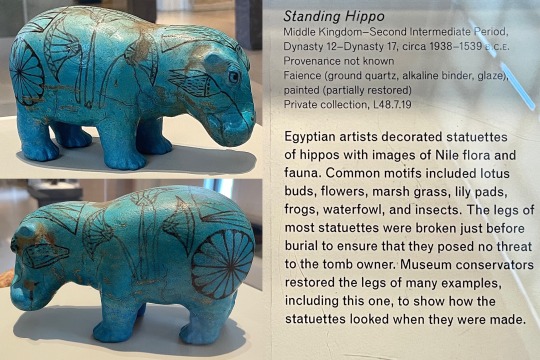
Standing Hippo
Middle Kingdom 2nd Int. Per. Dyn.12-17 c1938-1539BCE
Faience
“Egyptian artists decorated statuettes of hippos with images of Nile flora & fauna. Common motifs included lotus buds, flowers, marsh grass, lily pads, frogs, waterfowl, & insects. The legs of most statuettes were broken just before burial to ensure that they posed no threat to the tomb owner. Museum conservators restored the legs of many examples, including this one, to show how the statuettes looked when they were made.”
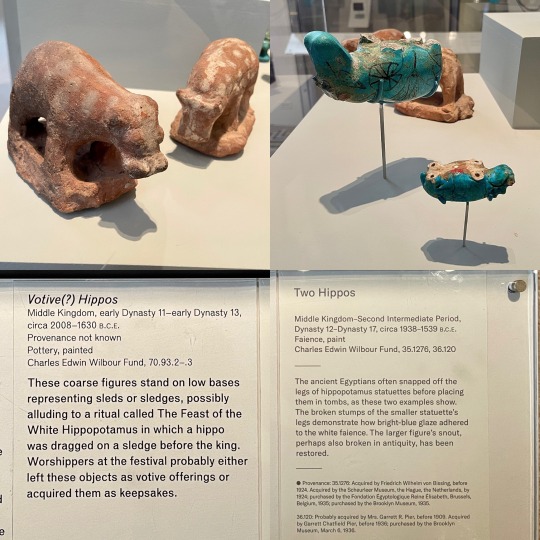
L: Votive(?) Hippos
Middle Kingdom Dyn.11-13 c2008-1630BCE
Painted pottery
“These coarse figures stand on low bases representing sleds or sledges, possibly alluding to a ritual called The Feast of the White Hippo in which a hippo was dragged on a sledge before the king. Worshippers at the festival probably either left these objects as votive offerings or acquired them as keepsakes.”
R: Two Hippos
Middle Kingdom Dyn.12-17 c1938-1539BCE
“The ancient Egyptians often snapped off the legs of hippopotamus statuettes before placing them in tombs, as these two examples show. The broken stumps of the smaller statuette's legs demonstrate how bright-blue glaze adhered to the white faience. The larger figure's snout, perhaps also broken in antiquity, has been restored.”
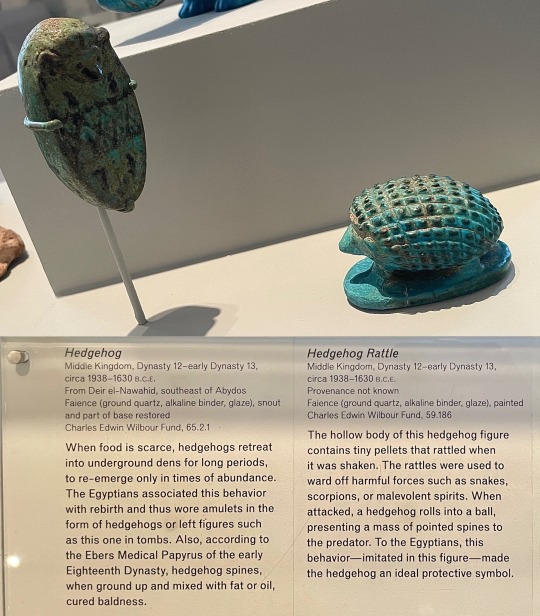
L. Hedgehog Rattle
Middle Kingdom Dyn. 12-13 c1938-1630BCE
Faience, 7.6 x 4.4 x 3.5 cm
“The hollow body of this hedgehog figure contains tiny pellets that rattled when it was shaken. The rattles were used to ward off harmful forces such as snakes, scorpions, or malevolent spirits. When attacked, a hedgehog rolls into a ball, presenting a mass of pointed spines to the predator. To the Egyptians, this behavior-_imitated in this figure-made the hedgehog an ideal protective symbol.”
R. Hedgehog Figurine
Middle Kingdom Dyn. 12-13 c1938-1630BCE
Faience, 4.2 x 4.1 x 7.1 cm
“When food is scarce, hedgehogs retreat into underground dens for long periods, to re-emerge only in times of abundance.
The Egyptians associated this behavior with rebirth and thus wore amulets in the form of hedgehogs or left figures such as this one in tombs. Also, according to the Ebers Medical Papyrus of the early Eighteenth Dynasty, hedgehog spines, when ground up and mixed with fat or oil, cured baldness.”
(note: labels are reversed - rattle is on L & figurine on R)
#animals in art#ancient art#Egyptian art#Ancient Egyptian art#Ancient Egypt#Brooklyn Museum#museum visit#hippo#hippos#hippopotamus#hippopotamuses#hedgehog#hedgehogs#pair#ceramics#pottery#faience#funerary art#votive#figurine#rattle
116 notes
·
View notes
Text
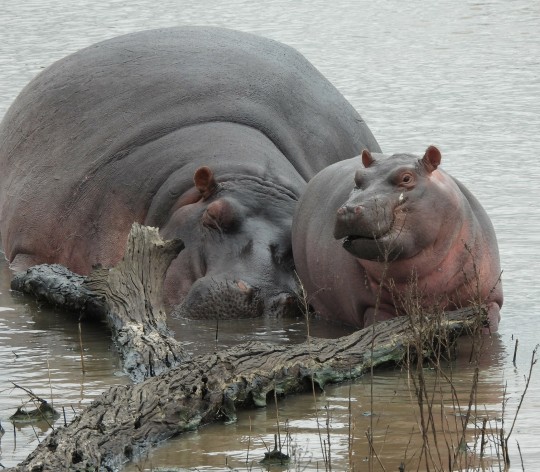
Common hippopotamus Hippopotamus amphibius
Observed by richard_johnstone, CC BY-NC
#Hippopotamus amphibius#common hippopotamus#Hippopotamidae#hippo#Africa#South Africa#Mpumalanga#juvenile
182 notes
·
View notes
Text

Common hippopotamus
By: G. Cubitt
From: The Complete Encyclopedia of the Animal World
1980
#common hippopotamus#hippo#ungulate#mammal#1980#1980s#G. Cubitt#The Complete Encyclopedia of the Animal World (1980)
79 notes
·
View notes
Text

A common hippopotamus (Hippopotamus amphibius) emerges from the water in Kruger National Park, South Africa
by jaffles
#common hippopotamus#hippopotamus#hippo#hippos#Hippopotamus amphibius#Hippopotamidae#artiodactyla#mammalia#chordata#wildlife: south africa#wildlife: africa
29 notes
·
View notes
Text
32 notes
·
View notes
Text
All animal species (and a couple algae) that have kept the same scientific name since Linnaeus
The first work of taxonomy that is considered as having any scientific authority for animal species was the 10th edition of Linnaeus' Systema Naturae, published in 1758. (Also a book on spiders called Aranei Suecici, published one year before.) That's the foundational text of the binominal system of nomenclature of species still in use today. Since then most of Linnaeus' original species (4379 species, of which 185 mammals, 554 birds, 217 "amphibians" (including reptiles and cartilaginous fish), 379 fishes, 2104 "insects" (including various arthropods, of which 664 are beetles and 543 are moths & butterflies crammed into only 3 genera), and 940 "worms" (including basically all other invertebrates, and even some protists and algae)) have been dismembered, renamed, or at least moved to different genera (e.g. the house sparrow went from Fringilla domestica to Passer domesticus).
Here is a list of all of Linnaeus' original species from 1758 that still retain their original name. I believe they are 484 in total.
"Mammalia"
(Primates)
Homo sapiens (human)
Lemur catta (ring-tailed lemur)
Vespertilio murinus (rearmouse bat)
(Bruta)
Elephas maximus (Asian elephant)
Trichechus manatus (West Indian manatee)
Bradypus tridactylus (three-toed sloth)
Myrmecophaga tridactyla (giant anteater)
Manis pentadactylus (Chinese pangolin)
(Ferae)
Phoca vitulina (harbor seal)
Canis familiaris (dog)
Canis lupus (grey wolf)
Felis catus (house cat)
Viverra zibetha (Indian civet)
Mustela erminea (stoat)
Mustela furo (ferret)
Mustela lutreola (European mink)
Mustela putorius (wild ferret)
Ursus arctos (brown bear)
(Bestiae)
Sus scrofa (wild boar/pig)
Dasypus septemcinctus (seven-banded armadillo)
Dasypus novemcinctus (nine-banded armadillo)
Erinaceus europaeus (European hedgehog)
Talpa europaea (European mole)
Sorex araneus (common shrew)
Didelphis marsupialis (common opossum)
(Glires)
Rhinoceros unicornis (Indian rhinoceros)
Hystrix brachyura (Malayan porcupine)
Hystrix cristata (crested porcupine)
Lepus timidus (common hare)
Castor fiber (European beaver)
Mus musculus (house mouse)
Sciurus vulgaris (red squirrel)
(Pecora)
Camelus dromedarius (dromedary camel)
Camelus bactrianus (Asian camel)
Moschus moschiferus (musk deer)
Cervus elaphus (red deer)
Capra hircus (goat)
Capra ibex (Alpine ibex)
Ovis aries (sheep)
Bos taurus (cow)
Bos indicus (zebu)
(Belluae)
Equus caballus (horse)
Equus asinus (donkey)
Equus zebra (mountain zebra)
Hippopotamus amphibius (hippopotamus)
(Cete)
Monodon monoceros (narwhal)
Balaena mysticetus (bowhead whale)
Physeter macrocephalus (sperm whale)
Delphinus delphis (common dolphin)
"Aves"
(Accipitres)
Vultur gryphus (Andean condor)
Falco tinnunculus (common kenstrel)
Falco sparverius (sparrowhawk)
Falco columbarius (pigeonhawk)
Falco subbuteo (Eurasian hobby)
Falco rusticolus (gyrfalcon)
Strix aluco (tawny owl)
Lanius excubitor (great grey shrike)
Lanius collurio (red-backed shrike)
Lanius schach (long-tailed shrike)
(Picae)
Psittacus erithacus (grey parrot)
Ramphastos tucanus (white-throated toucan)
Buceros bicornis (great hornbill)
Buceros rhinoceros (rhinoceros hornbill)
Crotophaga ani (smooth-billed ani)
Corvus corax (raven)
Corvus corone (carrion crow)
Corvus frugilegus (rook)
Corvus cornix (hooded crow)
Coracias oriolus (golden oriole)
Coracias garrulus (European roller)
Gracula religiosa (hill myna)
Paradisaea apoda (greater bird-of-paradise)
Cuculus canorus (common cuckoo)
Jynx torquilla (wryneck)
Picus viridis (green woodpecker)
Sitta europaea (Eurasian nuthatch)
Merops apiaster (European bee-eater)
Merops viridis (blue-throated bee-eater)
Upupa epops (Eurasian hoopoe)
Certhia familiaris (Eurasian treecreeper)
Trochilus polytmus (red-billed streamertail hummingbird)
(Anseres)
Anas platyrhynchos (mallard duck)
Anas crecca (teal duck)
Mergus merganser (common merganser)
Mergus serrator (red-breasted merganser)
Alca torda (razorbill auk)
Procellaria aequinoctialis (white-chinned petrel)
Diomedea exulans (wandering albatross)
Pelecanus onocrotalus (great white pelican)
Phaeton aethereus (red-billed tropicbird)
Larus canus (common gull)
Larus marinus (great black-backed gull)
Larus fuscus (lesser black-backed gull)
Sterna hirundo (common tern)
Rhynchops niger (black skimmer)
(Grallae)
Phoenicopterus ruber (American flamingo)
Platalea leucorodia (Eurasian spoonbill)
Platalea ajaia (roseate spoonbill)
Mycteria americana (wood stork)
Ardea cinerea (grey heron)
Ardea herodias (blue heron)
Ardea alba (great egret)
Scolopax rusticola (Eurasian woodcock)
Charadrius hiaticula (ringed plover)
Charadrius alexandrinus (Kentish plover)
Charadrius vociferus (killdeer plover)
Charadrius morinellus (Eurasian dotterel)
Recurvirostra avosetta (pied avocet)
Haematopus ostralegus (Eurasian oystercatcher)
Fulica atra (Eurasian coot)
Rallus aquaticus (water rail)
Psophia crepitans (grey-winged trumpeter)
Otis tarda (great bustard)
Struthio camelus (ostrich)
(Gallinae)
Pavo cristatus (Indian peafowl)
Meleagris gallopavo (wild turkey)
Crax rubra (great curassow)
Phasianus colchicus (common pheasant)
Tetrao urogallus (western capercaillie)
(Passeres)
Columba oenas (stock dove)
Columba palumbus (wood pigeon)
Alauda arvensis (Eurasian skylark)
Sturnus vulgaris (European starling)
Turdus viscivorus (mistle thrush)
Turdus pilaris (fieldfare thrush)
Turdus iliacus (redwing thrush)
Turdus plumbeus (red-legged thrush)
Turdus torquatus (ring ouzel)
Turdus merula (blackbird)
Loxia curvirostra (crossbill)
Emberiza hortulana (ortolan bunting)
Emberiza citrinella (yellowhammer)
Emberiza calandra (corn bunting)
Fringilla coelebs (common chaffinch)
Motacilla alba (white wagtail)
Motacilla lava (yellow wagtail)
Parus major (great tit)
Hirundo rustica (barn swallow)
Caprimulgus europaeus (European nightjar)
"Amphibia"
(Reptiles)
Testudo graeca (Greek tortoise)
Draco volans (flying dragon)
Lacerta agilis (sand lizard)
Rana temporaria (common frog)
(Serpentes)
Crotalus horridus (timber rattlesnake)
Crotalus durissus (tropical rattlesnake)
Boa constrictor (common boa)
Coluber constrictor (eastern racer)
Anguis fragilis (slowworm)
Amphisbaena alba (red worm lizard)
Caecilia tentaculata (white-bellied caecilian)
(Nantes)
Petromyzon marinus (sea lamprey)
Raja clavata (thornback ray)
Raja miraletus (brown ray)
Squalus acanthias (spiny dogfish)
Chimaera monstrosa (rabbitfish)
Lophius piscatorius (anglerfish)
Acipenser sturio (sea sturgeon)
Acipenser ruthenus (sterlet sturgeon)
"Pisces"
(Apodes)
Muraena helena (Mediterranean moray)
Gymnotus carapo (banded knifefish)
Trichiurus lepturus (cutlassfish)
Anarhichas lupus (Atlantic wolffish)
Ammodytes tobianus (lesser sandeel)
Xiphias gladius (swordfish)
Stromateus fiatola (blue butterfish)
(Jugulares)
Callionymus lyra (common dragonet)
Uranoscopus scaber (stargazer)
Trachinus draco (greater weever)
Gadus morhua (Atlantic cod)
Blennius ocellaris (butterfly blenny)
Ophidion barbatum (snake cusk-eel)
(Thoracici)
Cyclopterus lumpus (lumpsucker)
Echeneis naucrates (sharksucker)
Coryphaena equiselis (pompano)
Coryphaena hippurus (dorado)
Gobius niger (black goby)
Govius paganellus (rock goby)
Cottus gobio (European bullhead)
Scorpaena porcus (black scorpionfish)
Scorpaena scrofa (red scorpionfish)
Zeus faber (John Dory)
Pleuronectes platessa (European plaice)
Chaetodon striatus (banded butterflyfish)
Chaetodon capistratus (foureye butterflyfish)
Sparus aurata (gilt-head bream)
Labrus merula (brown wrasse)
Labrus mixtus (cuckoo wrasse)
Labrus viridis (green wrasse)
Sciaena umbra (brown meagre)
Perca fluviatilis (European perch)
Gasterosteus aculeatus (three-spined stickleback)
Scomber scombrus (Atlanti mackerel)
Mullus barbatus (red mullet)
Mullus surmuletus (surmullet)
Trigla lyra (piper gurnard)
(Abdominales)
Cobitis taenia (spined loach)
Silurus asotus (Amur catfish)
Silurus glanis (Wels catfish)
Loricaria cataphracta (suckermouth catfish)
Salmo carpio (Garda trout)
Salmo trutta (brown trout)
Salmo salar (Atlantic salmon)
Fistularia tabacaria (bluespotted cornetfish)
Esox lucius (northern pike)
Argentina sphyraena (European argentine)
Atherina hepsetus (Mediterranean sand smelt)
Mugil cephalus (flathead mullet)
Exocoetus volitans (tropical flying fish)
Polynemus paradiseus (Paradise threadfin)
Clupea harengus (Atlantic herring)
Cyprinus carpio (common carp)
(Branchiostegi)
Mormyrus caschive (bottlenose elephantfish)
Balistes vetula (queen triggerfish)
Ostracion cornutus (longhorn cowfish)
Ostracion cubicus (yellow boxfish)
Tetraodon lineatus (Fahaka pufferfish)
Diodon hystrix (spot-fin porcupinefish)
Diodon holocanthus (long-spine porcupinefish)
Centriscus scutatus (grooved shrimpfish)
Syngnathus acus (common pipefish)
Syngnathus pelagicus (pelagic pipefish)
Syngnathus typhle (broad-nosed pipefish)
Pegasus volitans (longtail seamoth)
"Insecta"
(Coleoptera)
Scarabaeus sacer (sacred scarab)
Dermestes lardarius (larder beetle)
Dermestes murinus (larder beetle)
Hister unicolor (clown beetle)
Hister quadrimaculatus (clown beetle)
Silpha obscura (carrion beetle)
Cassida viridis (tortoise beetle)
Cassida nebulosa (tortoise beetle)
Cassida nobilis (tortoise beetle)
Coccinella trifasciata (ladybug)
Coccinella hieroglyphica (ladybug)
[Coccinella 5-punctata, 7-punctata, 11-punctata, and 24-punctata survive as quinquepunctata, septempunctata, undecimpunctata, and vigintiquatorpunctata]
Chrysomela populi (leaf beetle)
Chrysomela lapponica (leaf beetle)
Chrysomela collaris (leaf beetle)
Chrysomela erythrocephala (leaf beetle)
Curculio nucum (nut weevil)
Attelabus surinamensis (leaf-rolling weevil)
Cerambyx cerdo (capricorn beetle)
Leptura quadrifasciata (longhorn beetle)
Cantharis fusca (soldier beetle)
Cantharis livida (soldier beetle)
Cantharis oscura (soldier beetle)
Cantharis rufa (soldier beetle)
Cantharis lateralis (soldier beetle)
Elater ferrugineus (rusty click beetle)
Cicindela campestris (green tiger beetle)
Cicindela sylvatica (wood tiger beetle)
Buprestis rustica (jewel beetle)
[Buprestis 8-guttata survives as octoguttata]
Dytiscus latissimus (diving beetle)
Carabus coriaceus (ground beetle)
Carabus granulatus (ground beetle)
Carabus nitens (ground beetle)
Carabus hortensis (ground beetle)
Carabus violaceus (ground beetle)
Tenebrio molitor (mealworm)
Meloe algiricus (blister beetle)
Meloe proscarabaeus (blister beetle)
Meloe spec (blister beetle)
Mordela aculeata (tumbling glower beetle)
Necydalis major (longhorn beetle)
Staphylinus erythropterus (rove beetle)
Forficula auricularia (common earwig)
Blatta orientalis (Oriental cockroach)
Gryllus campestris (field cricket)
(Hemiptera)
Cicada orni (cicada)
Notonecta glauca (backswimmer)
Nepa cinerea (water scorpion)
Cimex lectularius (bedbug)
Aphis rumici (black aphid)
Aphis craccae (vetch aphid)
Coccus hesperidum (brown scale insect)
Thrips physapus (thrips)
Thrips minutissimum (thrips)
Thrips juniperinus (thrips)
(Lepidoptera)
Papilio paris (Paris peacock butterfly)
Papilio helenus (red Helen butterfly)
Papilio troilus (spicebush swallowtail butterfly)
Papilio deiphobus (Deiphobus swallowtail butterfly)
Papilio polytes (common Mormon butterfly)
Papilio glaucus (eastern tiger swallowtail butterfly)
Papilio memnon (great Mormon butterfly)
Papilio ulysses (Ulysses butterfly)
Papilio machaon (Old World swallowtail butterfly)
Papilio demoleus (lime swallowtail butterfly)
Papilio nireus (blue-banded swallowtail butterfly)
Papilio clytia (common mime butterfly)
Sphinx ligustri (privet hawk-moth)
Sphinx pinastri (pine hawk-moth)
[genus Phalaena was suppressed, but seven subgenera created by Linnaeus are now valid as genera]
(Neuroptera)
Libellula depressa (chaser dragonfly)
Libellula quadrimaculata (four-spotted skimmer dragonfly)
Ephemera vulgata (mayfly)
Phryganea grandis (caddisfly)
Hemerobius humulinus (lacewing)
Panorpa communis (scorpionfly)
Panorpa germanica (scorpionfly)
Raphidia ophiopsis (snakefly)
(Hymenoptera)
Cynips quercusfolii (oak gall wasp)
Tenthredo atra (sawfly)
Tenthredo campestris (sawfly)
Tenthredo livida (sawfly)
Tenthredo mesomela (sawfly)
Tenthredo scrophulariae (sawfly)
Ichneumon extensorius (parasitoid wasp)
Ichneumon sarcitorius (parasitoid wasp)
Sphex ichneumoneus (digger wasp)
Vespa crabro (European hornet)
Apis mellifera (honey bee)
Formica fusca (silky ant)
Mutilla europaea (large velvet ant)
(Diptera)
Oestrus ovis (sheep botfly)
Tipula oleracea (marsh cranefly)
Tipula hortorum (cranefly)
Tipula lunata (cranefly)
Musca domestica (housefly)
Tabanus bovinus (pale horsefly)
Tabanus calens (horsefly)
Tabanus bromius (brown horsefly)
Tabanus occidentalis (horsefly)
Tabanus antarcticus (horsefly)
Culex pipiens (house mosquito)
Empis borealis (dance fly)
Empis pennipes (dance fly)
Empis livida (dance fly)
Conops flavipes (thick-headed fly)
Asilus barbarus (robberfly)
Asilus crabroniformis (hornet robberfly)
Bombylius major (bee fly)
Bombylius medius (bee fly)
Bombylius minor (bee fly)
Hippobosca equina (forest fly)
(Aptera)
Lepisma saccharina (silverfish)
Podura aquatica (water springtail)
Termes fatale (termite)
Pediculus humanus (human louse)
Pulex irritans (human flea)
Acarus siro (flour mite)
Phalangium opilio (harvestman)
Araneus angulatus (orb-weaving spider)
Araneus diadematus (European garden spider)
Araneus marmoreus (marbled orbweaver)
Araneus quadratus (four-spotted orbweaver -- last four are by Clerck 1757, some of the very few surviving pre-Linnean names!)
Scorpio maurus (large-clawed scorpion)
Cancer pagurus (brown crab)
Oniscus asellus (common woodlouse)
Scolopendra gigantea (giant centipede)
Scolopendra morsitans (red-headed centipede)
Julus fuscus (millipede)
Julus terrestris (millipede)
"Vermes"
(Intestina)
Gordius aquaticus (horsehair worm)
Lumbricus terrestris (common earthworm)
Ascaris lumbricoides (giant roundworm)
Fasciola hepatica (liver fluke)
Hirudo medicinalis (medicinal leech)
Myxine glutinosa (Atlantic hagfish)
Teredo navalis (shipworm)
[shout out to Furia infernalis, a terrifying carnivorous jumping worm that Linnaeus described, but which doesn't seem to actually exist]
(Mollusca)
Limax maximus (leopard slug)
Doris verrucosa (warty nudibranch)
Nereis caerulea (ragworm)
Nereis pelagica (ragworm)
Aphrodita aculeata (sea mouse)
Lernaea cyprinacea (anchor worm)
Scyllaea pelagica (Sargassum nudibranch)
Sepia officinalis (common cuttlefish)
Asterias rubens (common starfish)
Echinus esculentus (edible sea urchin)
(Testacea)
Chiton tuberculatus (West Indian green chiton)
Lepas anatifera (goose barnacle)
Pholas dactylus (common piddock)
Mya arenaria (softshell clam)
Mya truncata (truncate softshell)
Solen vagina (razor clam)
Tellina laevigata (smooth tellin)
Tellina linguafelis (cat-tongue tellin)
Tellina radiata (sunrise tellin)
Tellina scobinata (tellin)
Cardium costatum (ribbed cockle)
Donax cuneatus (wedge clam)
Donas denticulatus (wedge clam)
Donax trunculus (wedge clam)
Venus casina (Venus clam)
Venus verrucosa (warty venus)
Spondylus gaederopus (thorny oyster)
Spondylus regius (thorny oyster)
Chama lazarus (jewel box shell)
Chama gryphoides (jewel box shell)
Arca noae (Noah's ark shell)
Ostrea edulis (edible oyster)
Anomia aurita (saddle oyster)
Anomia ephippium (saddle oyster)
Anomia hysterita (saddle oyster)
Anomia lacunosa (saddle oyster)
Anomia spec (saddle oyster)
Anomia striatula (saddle oyster)
Mytilus edulis (blue mussel)
Pinna muricata (pen shell)
Pinna nobilis (fan mussel)
Pinna rudis (rough pen shell)
Argonauta argo (argonaut)
Nautilus pompilius (chambered nautilus)
Conus ammiralis (admiral cone snail)
Conus aulicus (princely cone snail)
Conus aurisiacus (cone snail)
Conus betulinus (betuline cone snail)
Conus bullatus (bubble cone snail)
Conus capitaneus (captain cone snail)
Conus cedonulli (cone snail)
Conus ebraeus (black-and-white cone snail)
Conus figulinus (fig cone snail)
Conus genuanus (garter cone snail)
Conus geographus (geographer cone snail)
Conus glaucus (glaucous cone snail)
Conus granulatus (cone snail)
Conus imperialis (imperial cone snail)
Conus litteratus (lettered cone snail)
Conus magus (magical cone snail)
Conus marmoreus (marbled cone snail)
Conus mercator (trader cone snail)
Conus miles (soldier cone snail)
Conus monachus (monastic cone snail)
Conus nobilis (noble cone snail)
Conus nussatella (cone snail)
Conus princeps (prince cone snail)
Conus spectrum (spectrecone snail)
Conus stercusmuscarum (fly-specked cone snail)
Conus striatus (striated cone snail)
Conus textile (cloth-of-gold cone snail)
Conus tulipa (tulip cone snail)
Conus varius (freckled cone snail)
Conus virgo (cone snail)
Cypraea tigris (tiger cowry shell)
Bulla ampulla (Pacific bubble shell)
Voluta ebraea (Hebrew volute)
Voluta musica (music volute)
Buccinum undatum (common whelk)
Strombus pugilis (fighting conch)
Murex tribulus (caltrop murex)
Trochus maculatus (maculated top shell)
Turbo acutangulus (turban shell)
Turbo argyrostomus (silver-mouth turban shell)
Turbo chrystostomus (gold-mouth turban shell)
Turbo marmoratus (green turban shell)
Turbo petholatus (turban shell)
Turbo sarmaticus (giant turban shell)
Helix lucorum (Mediterranean snail)
Helix pomatia (Roman snail)
Nerita albicilla (blotched nerite)
Nerita chamaeleon (nerite)
Nerita exuvia (snakeskin nerite)
Nerita grossa (nerite)
Nerita histrio (nerite)
Nerita peloronta (bleeding tooth)
Nerita plicata (nerite)
Nerita polita (nerite)
Nerita undata (nerite)
Haliotis asinina (ass-ear abalone)
Haliotis marmorata (marbled abalone)
Haliotis midae (South African abalone)
Haliotis parva (canaliculate abalone)
Haliotis tuberculata (green ormer)
Haliotis varia (common abalone)
Patella caerulea (Mediterranean limpet)
Patella pellucida (blue-rayed limpet)
Patella vulgata (European limpet)
Dentalium elephantinum (elephant tusk)
Dentalium entale (tusk shell)
[genus Serpula is still in use with none of its original species]
(Lithophyta)
Tubipora musica (organ pipe coral)
Millepora alcicornis (sea ginger fire coral)
Madrepora oculata (zigzag stone coral)
(Zoophyta)
Isis hippuris (sea bamboo)
Isis ochracea (sea bamboo)
Gorgonia flabellum (Venus fan)
Gorgonia ventalina (purple sea fan)
Alcyonium bursa (soft coral)
Alcyonium digitatum (dead man's fingers)
Tubularia indivisa (oaten ipes hydroid)
Corallina officinalis (coralline red alga)
Sertularia argentea (sea fern)
Sertularia cupressoides (hydroid)
Pennatula phosphorea (sea pen)
Taenia solium (pork tapeworm)
Volvox globator (colonial alga)
[genus Hydra is still in use with none of its original species]
15 notes
·
View notes
Text
Consider Art I: 2022
Happy Holidays! I hope everyone is having a pleasant holiday season and has recovered from blacking out from Thanksgiving gravy poisoning. This holiday season, I’d like to introduce a new tradition at Consider Nature. As you may know, Consider Nature is dedicated to shining a spotlight on some of the animal kingdom’s most underrated members, animals who get overlooked despite being fucking awesome. To help highlight the beauty of these funky little guys, I would like to introduce the first Consider Art Competition!
For Consider Art, artists are asked to create pieces depicting or inspired by an animal covered in the Consider Nature blog. For those who are not familiar with the blog, I have written articles on the following animals:
Olm (Proteus anguinus)
Indian Purple Frog (Nasikabatrachus sahyadrensis)
Pygmy Hippopotamus (Choeropsis liberiensis)
Scaly-foot Snail (Chrysomallon squamiferum)
Kaua’i Cave Wolf Spider (Adelocosa anops)
Shoebill (Balaeniceps rex)
Submissions will be judged based on their originality, quality, successful depiction of the animal, and whether or not the judges of the competition and I subjectively like it. All submissions are due JANUARY 6TH! Please check the submission guidelines below before entering your piece, as there is a specific process for entering a piece of art in this competition.
Prizes:
Here at Consider Nature, we are aware that exposure doesn't do a very good job of putting food on an artist's table. So, the top three art pieces submitted for the competition will receive prizes (they aren't going to be big prizes because I don't do this for money, but I'll do my best). The winning artists may choose to receive their prize as an Amazon or Etsy gift card (depending on how much they hate Jeff Bezos).
First place will receive a $50 Amazon or Etsy gift card.
Second place will receive a $25 Amazon or Etsy gift card.
Third place will receive a $10 Amazon or Etsy gift card.
All winning pieces will also be posted on the Consider Nature blog as well as on our social media (with full credit to the artists and links to their social media). Honorable mentions may also be awarded as part of this competition, depending on how many entries there are. These pieces will not receive a cash prize.
Submission Guidelines:
Any kind of art will be accepted for this competition. Keep in mind that if you make a physical drawing, painting, or sculpture, you will need to photograph or scan it to submit.
All submissions must be entered by January 6th, 2023. No entries will be considered after this time!
Please submit your piece as PDF, JPEG, or other common image file type. Pieces that cannot be opened by the judges on an average computer will not be considered.
To enter your piece into the competition, complete the following steps:
Email your submission to [email protected]
Post your submission on Instagram or Tumblr, using the hashtag #considerart2022.
When you post your piece, please provide a link to the Consider Nature article that corresponds to the animal represented in your piece. This will help other people find and enjoy Consider Nature.
Please make sure that you follow these submission guidelines, as improperly-submitted pieces may not be considered.
Rules:
Work submitted for this competition must be the artist's own original work.
Art made using AI tools such as DALL-E or Nightcafe will not be considered for this competition.
Pieces submitted must represent one of the animals covered in Consider Nature blogs.
Consider Nature has the right to reproduce pieces submitted for this competition on social media or on the Consider Nature website for the purpose of promoting the artist’s work or the Consider Nature blog. To be clear, pieces submitted for this competition will never be merchandised in any way without the artist’s express permission (and artists will be compensated).
#art#competition#considerart2022#animals#considernature#conservation#wildlife#nature#biology#zoology#science#ecology#cute animals#environment
75 notes
·
View notes